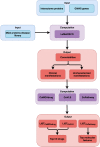Prediction of severe adverse events, modes of action and drug treatments for COVID-19's complications
- PMID: 34675303
- PMCID: PMC8531388
- DOI: 10.1038/s41598-021-00368-6
Prediction of severe adverse events, modes of action and drug treatments for COVID-19's complications
Abstract
Following SARS-CoV-2 infection, some COVID-19 patients experience severe host driven adverse events. To treat these complications, their underlying etiology and drug treatments must be identified. Thus, a novel AI methodology MOATAI-VIR, which predicts disease-protein-pathway relationships and repurposed FDA-approved drugs to treat COVID-19's clinical manifestations was developed. SARS-CoV-2 interacting human proteins and GWAS identified respiratory failure genes provide the input from which the mode-of-action (MOA) proteins/pathways of the resulting disease comorbidities are predicted. These comorbidities are then mapped to their clinical manifestations. To assess each manifestation's molecular basis, their prioritized shared proteins were subject to global pathway analysis. Next, the molecular features associated with hallmark COVID-19 phenotypes, e.g. unusual neurological symptoms, cytokine storms, and blood clots were explored. In practice, 24/26 of the major clinical manifestations are successfully predicted. Three major uncharacterized manifestation categories including neoplasms are also found. The prevalence of neoplasms suggests that SARS-CoV-2 might be an oncovirus due to shared molecular mechanisms between oncogenesis and viral replication. Then, repurposed FDA-approved drugs that might treat COVID-19's clinical manifestations are predicted by virtual ligand screening of the most frequent comorbid protein targets. These drugs might help treat both COVID-19's severe adverse events and lesser ones such as loss of taste/smell.
© 2021. The Author(s).
Conflict of interest statement
The authors declare no competing interests.
Figures
Similar articles
-
SAveRUNNER: A network-based algorithm for drug repurposing and its application to COVID-19.PLoS Comput Biol. 2021 Feb 5;17(2):e1008686. doi: 10.1371/journal.pcbi.1008686. eCollection 2021 Feb. PLoS Comput Biol. 2021. PMID: 33544720 Free PMC article.
-
Lung disease network reveals impact of comorbidity on SARS-CoV-2 infection and opportunities of drug repurposing.BMC Med Genomics. 2021 Sep 17;14(1):226. doi: 10.1186/s12920-021-01079-7. BMC Med Genomics. 2021. PMID: 34535131 Free PMC article.
-
Implications of Low-grade Inflammation in SARS-CoV-2 Immunopathology.MEDICC Rev. 2021 Apr;23(2):42. doi: 10.37757/MR2021.V23.N2.4. Epub 2021 Apr 30. MEDICC Rev. 2021. PMID: 33974614 Review.
-
COVID-19's Clinical-Pathological Evidence in Relation to Its Repercussion on the Central and Peripheral Nervous System.Adv Exp Med Biol. 2021;1353:197-215. doi: 10.1007/978-3-030-85113-2_11. Adv Exp Med Biol. 2021. PMID: 35137375 Review.
-
SARS-CoV-2 Induced Neurological Manifestations Entangles Cytokine Storm that Implicates for Therapeutic Strategies.Curr Med Chem. 2022;29(12):2051-2074. doi: 10.2174/0929867328666210506161543. Curr Med Chem. 2022. PMID: 33970839 Review.
Cited by
-
A mode of action protein based approach that characterizes the relationships among most major diseases.Sci Rep. 2025 Mar 20;15(1):9668. doi: 10.1038/s41598-025-93377-8. Sci Rep. 2025. PMID: 40113859 Free PMC article.
-
PHEVIR: an artificial intelligence algorithm that predicts the molecular role of pathogens in complex human diseases.Sci Rep. 2022 Dec 3;12(1):20889. doi: 10.1038/s41598-022-25412-x. Sci Rep. 2022. PMID: 36463386 Free PMC article.
References
Publication types
MeSH terms
Grants and funding
LinkOut - more resources
Full Text Sources
Medical
Miscellaneous


